Thousands of people have already filed past Queen Elizabeth II’s coffin,with the first members of the public paying their respects to the monarch shortly after 5pm London time (2am Thursday AEST).
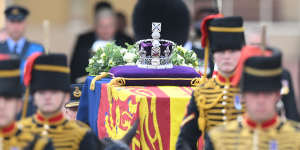
The Imperial State Crown rests on the coffin of Queen Elizabeth II.Getty
Ceremonial viewing areas along the procession route were full an hour before the coffin began its journey,with mourners being turned away and told to head to the large screens in nearby Hyde Park.
Tens of thousands more people lined The Mall in near-silence as King Charles III and his siblings walked behind the oak casket during a 38-minute procession from the palace to Westminster Hall.
The casket,draped with the Royal Standard,was carried by gun carriage drawn by the King’s Troop Royal Horse Artillery. The Imperial State Crown sat on a velvet cushion next to a wreath of white roses which included pine from the gardens of the Queen’s beloved Balmoral estate in Scotland and lavender and rosemary from the gardens at Windsor Castle.
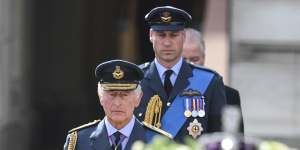
King Charles III and Prince William,the Prince of Wales,walk behind the coffin.Getty
William,the Prince of Wales,and his brother,Harry,the Duke of Sussex,joined their father in a time-honoured tradition of royal duty;they had walked behind their mother’s coffin in different circumstances 25 years ago.
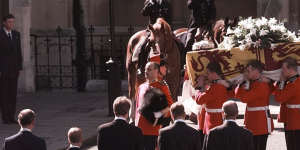
The scenes were reminiscent of Princess Diana’s funeral procession 25 years ago,when princes William and Harry followed their mother’s coffin.POOL
The sun shone as Wednesday’s procession moved onto The Mall in central London and members of the crowd threw yellow roses on the road.
Mourners,some of whom had flown in from overseas for the event,could be seen crying as the coffin passed.
An eerie silence was broken only by minute guns fired from Hyde Park whilst the coffin moved towards the Palace of Westminster.
The bells of Big Ben,having finally broken free of scaffolding in recent months following an £80 million ($137 million),five-year restoration project,were tolled at one-minute intervals.
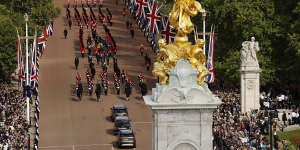
The procession makes its way from Buckingham Palace to Westminster Hall.Getty
William and Harry were joined by their cousin,Peter Phillips,Princess Anne’s husband,Vice Admiral Sir Timothy Laurence,the Queen’s cousin,the Duke of Gloucester,and the Earl of Snowdon and son of the Queen’s late sister,Princess Margaret.
It was the first time the Queen’s grandchildren and their spouses joined the ceremonial mourning.
Camilla,Queen Consort,Catherine,Princess of Wales,Meghan,Duchess of Sussex,and Sophie,Countess of Wessex,travelled to Westminster by car.
at Balmoral,in the Scottish Highlands,at the age of 96,plunging the nation into 10 days of national mourning.
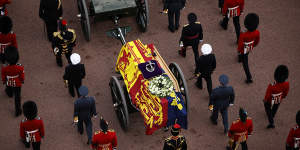
Queen Elizabeth II’s flag-draped coffin on The Mall.Getty
Wednesday’s procession was designed as a small and personal occasion ahead of the state funeral on Monday. The coffin was also accompanied by members of the military,the Queen’s closest personal staff and the King’s household.
The Band of the Scots Guards and the Band of the Grenadier Guards played funeral marches throughout the procession,starting with Beethoven’sFuneral March No.1.
Tracy Vo speaks to people prepared to wait days to pay their respects.
The Archbishop of Canterbury,supported by the Dean of Westminster,conducted a short service in the hall,also attended by parliamentarians from Westminster and the devolved parliaments of Scotland,Wales and Northern Ireland,as well as high commissioners of the realms,the countries where the royalty is head of state.
The choir of the chapel royal greeted the arrival of the coffin with Psalm 139:“You have searched me,Lord,and you know me.”
The Queen’s children are expected to pay their own tributes,standing guard around the coffin — a tradition known as the Vigil of the Princes — as they did in Edinburgh earlier this week.
At Westminster Hall,the Queen will lie in state until the morning of her funeral on Monday,with a near-constant stream of members of the public filing past her coffin.
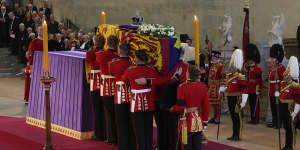
The coffin arrives at Westminster Hall,where it will remain for the next four days.AP
Mourners are facing queues up to eight kilometres long to pay their respects to the Queen as she lies in state. Many are expected to be turned away with officials forecasting only 350,000 will be able to complete a viewing before Monday’s funeral.
About 500 dignitaries from across the world are expected to pay their last respects to the long-reigning monarch.
They will join members of the royal family,UK prime ministers past and present,and key figures from public life for the funeral at Westminster Abbey which can hold about 2000 people.

Invitations to the Queen’s state funeral have not been sent to Syria,Venezuela or Taliban-ruled Afghanistan.
While most countries around the world have been invited to send their head of state,those three countries join Russia,Belarus and Myanmar on the list of nations not asked to send a representative.
North Korea and Nicaragua have been invited only at ambassadorial level,joining Iran in that category.
The King will have a private day of reflection on Thursday after a momentous period that saw him become monarch.
He has returned to his Highgrove home in Gloucestershire and is not expected to attend any public events.
In the detailed planning for the aftermath of Queen Elizabeth II’s death – known as “London Bridge” – a day was set aside at this point for the new monarch to have some time away from public duties.
Get a note directly from our foreigncorrespondentson what’s making headlines around the world..